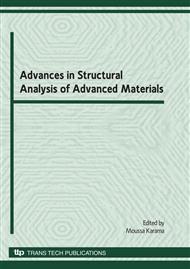[1]
R. I. Jones: The More Electric Aircraft: The Past and The Future?, College of Aeronautics, Cranfield University, (1999).
Google Scholar
[2]
R. E. J. Quigley: More electric aircraft, APEC, pp.906-911, March (1993).
Google Scholar
[3]
J. A. Weimer: The role of electric machines and drives in the more electric aircraft, International Electric Machines and Drives Conference, vol. 1, pp.11-15, June (2003).
DOI: 10.1109/iemdc.2003.1211236
Google Scholar
[4]
O. Langlois, E. Foch, X. Roboam, H. Piquet: De l'avion plus électrique à l'avion tout électrique : état de l'art et prospective sur les réseaux de bord", J3eA, Jour. sur l'enseignement des sciences et technologies de l, info. et des syst., Volume 4, Hors-Série 1(1), (2005).
DOI: 10.1051/bib-j3ea:2005601
Google Scholar
[5]
A. Zéanh, O. Dalverny, M. Karama, É. Woirgard, S. Azzopardi, A. Bouzourene, J. Casutt, M. Mermet-Guyennet: Thermomechanical Modelling and Reliability Study of an IGBT Module for an Aeronautical Application, EuroSimE 2008, Freiburg, (2008).
DOI: 10.1109/esime.2008.4525082
Google Scholar
[6]
T. Lhommeau, R. Meuret, M. Karama, Technological study of an IGBT module for an aeronautical application in zone engine, 11th European Conference on Power Electronics and Applications (EPE 2005, Dresden), Paper N°895, ISBN: 90-75815-08-5, (2005).
DOI: 10.1109/epe.2005.219735
Google Scholar
[7]
A. Zéanh, O. Dalverny, M. Karama, É. Woirgard, S. Azzopardi, A. Bouzourene, J. Casutt, M. Mermet-Guyennet: Reliability of the connections used in IGBT modules, in aeronautical environment, International Journal for Simulation and Multidisciplinary Design Optimization (IJSMDO), Vol 2, pp.123-133, (2008).
DOI: 10.1051/smdo:2008017
Google Scholar
[8]
Ciappa, M.: Selected failure mechanisms of modern power modules, Microelectronics reliability, Vol. 42, issues 4-5, pp.653-667, (2002).
DOI: 10.1016/s0026-2714(02)00042-2
Google Scholar
[9]
USA Department of defence, MIL-HDBK-217F: Reliability prediction of electronic equipment, (1991).
Google Scholar
[10]
DO 160, Environmental condition and test procedures for airborne equipment, RTCA Incorporated, (1997).
Google Scholar
[11]
D. Martineau, T. Mazeaud, M. Legros, Ph. Dupuy, C. Levade, G. Vanderschaeve: Characterization of ageing failures on power MOSFET devices by electron and ion microscopies, Microelectronics Reliability, Vol 49, pp.1330-1333, (2009).
DOI: 10.1016/j.microrel.2009.07.011
Google Scholar
[12]
W. Engelmaier, Solder Joints in Electronics: Design for Reliability, the Minerals, Metals & Materials Society, Warrendale, PA, pp.9-19, February (1997).
Google Scholar
[13]
W. W. Lee, L. T. Nguyen, G. S. Selvaduray, Solder Joint Fatigue Models: Review and Applicability to Chip Scale packages, Microelectronics Reliability, Vol. 40, pp.231-244, (2000).
DOI: 10.1016/s0026-2714(99)00061-x
Google Scholar
[14]
A. Micol, A. Zéanh, T. Lhommeau, S. Azzopardi, E. Woirgard, O. Dalverny, M. Karama, An investigation into the reliability of power modules considering baseplate solders thermal fatigue in aeronautical applications, Microelectronics Reliability, Vol 49, pp.1370-1374, (2009).
DOI: 10.1016/j.microrel.2009.06.046
Google Scholar
[15]
T. Miyazaki, T. Omata, Electromigration degradation mechanism for pb-free flip-chip micro solder bumps, Microelectronics Reliability, vol 46, pp.1898-1903, (2006).
DOI: 10.1016/j.microrel.2006.07.088
Google Scholar
[16]
C. P. Wong, J. M. Segelken, J. W. Balde, Understanding the use of silicone gels for nonhermetic plastic packaging, IEEE Transactions on Components, Hybrids, and Manufacturing Technology, Volume 12, Issue 4, pp.421-425, Dec (1989).
DOI: 10.1109/33.48998
Google Scholar
[17]
G. Mitic, G. Lefranc, Localization of electrical-insulation and partial-discharge failures of IGBT modules, IEEE Trans. on Indust. Applications, Volume 38, Issue 1, pp.175-180, (2002).
DOI: 10.1109/28.980373
Google Scholar
[18]
L. Dupont, Z. Khatir, S. Lefebvre, R. Meuret, B. Parmentier, S. Bontemps: Electrical characterizations and evaluation of thermo-mechanical stresses of a power module dedicated to high temperature applications, European Conference on Power Electronics and Applications, 11-14 Sept. (2005).
DOI: 10.1109/epe.2005.219580
Google Scholar
[19]
X. S. Ning, Y. Lin, W. Xu, R. Peng, H. Zhou, K. Chen: Development of a directly bonded aluminium/alumina power electronic substrate, Materials Science and Engineering: B, Volume 99, N°1, pp.479-482, (2003).
DOI: 10.1016/s0921-5107(02)00485-3
Google Scholar
[20]
T. Joyeux, M. El Ganaoui, J. Jarrige, J. -P. Lecompte: Réalisation d'un assemblage Cu/AlN améliorant les propriétés thermiques : expériences et simulation, Physical and Chemical News PCN, 3, pp.14-18, (2004).
Google Scholar
[21]
KYOCERA: Kyocera Power Module Substrate Si3N4 AMB Substrate, Kyocera Corporation, AMB vers6. 1, (2004).
Google Scholar
[22]
E. Gürses, C. Miehe: A computational framework of three-dimensional configurational-forcedriven brittle crack propagation, Comp. Meth. in Applied Mech. and Engineering, Volume 198, Issues 15-16, pp.1413-1428, (2009).
DOI: 10.1016/j.cma.2008.12.028
Google Scholar
[23]
J. -M. Haussonne, C. Carry, P. Bowen, J. Barton: Céramiques et verres, principes et techniques d'élaboration, Presse polytechniques et universitairtes romandes, (2005).
Google Scholar
[24]
M. F. Ashby, Materials Selection in Mechanical Design, Third Edition, ButterworthHeinemann, (2005).
Google Scholar
[25]
J. Lamon, A. G. Evans, Statistical analysis of bending strengths for brittle solids: A multiaxial fracture problem, Journal of the American Ceramic Society, 66(3) 177-182, (1983).
DOI: 10.1111/j.1151-2916.1983.tb10012.x
Google Scholar
[26]
P. Stanley, H. Fessler, & A. D. Sevill, An engineer's approach to the prediction of failure probability of brittle components, Proc. Brit. Ceram. Soc., 22 453-87, (1973).
Google Scholar
[27]
L. J. M. G. Dortmans & G. De With, Weakest-link Failure Predictions for Ceramics Using Finite Element Post-processing, Nether. Jour. of the European Ceram. Soc. 6 369-374, (1990).
DOI: 10.1016/0955-2219(90)90004-y
Google Scholar
[28]
Curamik® Electronics gmbh, Design Rules für curamik® DCB-Substrate, www. curamik. de.
Google Scholar
[29]
J. Lemaître, J. -L. Chaboche, Mécanique des Matériaux solides, Edition Dunod, (1985).
Google Scholar
[30]
http: /aluminium. matter. org. uk.
Google Scholar
[31]
A. D. Freed, Thermoviscoplastic Model With Application to Copper, NASA Technical Paper 2845. (1988).
Google Scholar
[32]
Alstom Internal report: Finite Element Analysis of manufacturing process for Cu-Al2O3-Cu insulating laminates for GTO Assemblies, ERC/WP/91. 0492.
Google Scholar
[33]
Alstom Internal report: The effect of geometrical variations on the probability of PostManufacturing cracking of Cu-Al2O3-Cu laminates for traction applications, ERC/R/91. 0575.
Google Scholar
[34]
M. Mermet-Guyennet, New structure of power integrated module, Proceedings of the CIPS, Naples, Italy, June 7-9, (2006).
Google Scholar


